Pedigree Analysis | Anthropology Optional for UPSC PDF Download
Introduction
- A pedigree is a visual representation that illustrates the inheritance patterns of specific traits or characteristics across multiple generations within a family. In other words, it is a diagram that showcases the relationships among family members, particularly in large extended families, using symbols and lines to indicate descent. Pedigrees play a crucial role in determining the inheritance patterns of various genetic diseases.
- To comprehend the inheritance patterns, the family history is traced by creating a family tree using standardized symbols. In a pedigree, males and females are represented by distinct symbols, and relationships are depicted with various line patterns. Furthermore, individuals who are affected by or carry a genetic trait are represented by specific symbols. Figure 1 displays the symbols, line patterns, and other characteristics used in a pedigree chart.
- By analyzing pedigrees, researchers and medical professionals can better understand the inheritance patterns of genetic diseases and traits within a particular family. This knowledge can then be used to inform genetic counseling, medical treatment, and other healthcare decisions.
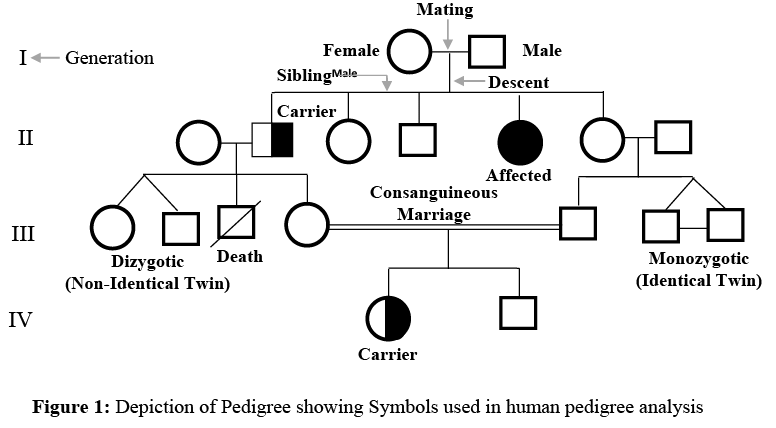
Methods of Pedigree analysis and its Importance
An analysis of pedigree can help us understand the nature of inheritance for a specific trait. Inheritance patterns can be autosomal (recessive and dominant), X-linked (recessive and dominant), or Y-linked. Some of these inheritance patterns are discussed below.
(a) Autosomal Recessive Inheritance
- Autosomal recessive inheritance is characterized by the presence of two recessive alleles on the autosomal chromosome. An individual with these two recessive alleles will display the affected phenotype, while those with the corresponding autosomal dominant allele will show the unaffected phenotype. The affected phenotype can appear in the offspring of parents who do not display the affected trait, and both male and female offspring can be equally affected. In order for a recessive homozygous individual to be conceived, both parents must carry the affected allele. The likelihood of producing an affected individual usually depends on the chance of two heterozygote carriers coming together, and this chance increases when mating occurs between relatives. Mating between relatives results in a higher risk of producing offspring with the affected homozygous recessive phenotype than mating between non-relatives. As a result, marriages between first cousins or close relatives account for a significant portion of recessive diseases in human populations.
- Albinism is an example of an autosomal recessive disorder caused by a defect in the enzyme responsible for synthesizing melanin. Affected individuals, known as albinos, have light-colored hair, a lack of skin pigmentation, and pink eye pupils due to the visibility of red hemoglobin pigment in blood vessels in the retina. For example, let's consider that the affected allele for albinism is represented by 'a' and the normal allele by 'A'. An affected individual with albinism would have the genotype 'aa', while unaffected individuals would have either 'AA' or 'Aa' genotypes (Figure 2).

In order for a recessive homozygote individual to be conceived, both parents must carry the affected allele. The creation of an affected individual typically relies on the likelihood of a union between heterozygote carriers. This probability of being affected increases when mating occurs between relatives, as mating within families results in a higher risk.
(b) Autosomal Dominant inheritance
- Autosomal dominant inheritance is a pattern of genetic inheritance where a single dominant allele, located on an autosome, is responsible for expressing a particular trait. This means that the abnormal allele is dominant, while the normal allele is recessive. In this type of inheritance, affected individuals typically appear in every generation since they inherit the abnormal allele from one of their affected parents. As a result, each affected individual has at least one affected parent. Additionally, only one affected parent, either the mother or the father, is sufficient to pass on the trait to their children, and the chances of inheritance are the same for both sons and daughters.
- Some common examples of human autosomal dominant disorders include Achondroplasia, Huntington's disease, and Phenylthiocarbamide (PTC) taste sensitivity. In a pedigree chart for a dominant disorder like PTC sensitivity, individuals who can taste bitterness are denoted by either 'TT' or 'Tt', while individuals who cannot taste bitterness are represented by the 'tt' genotype.
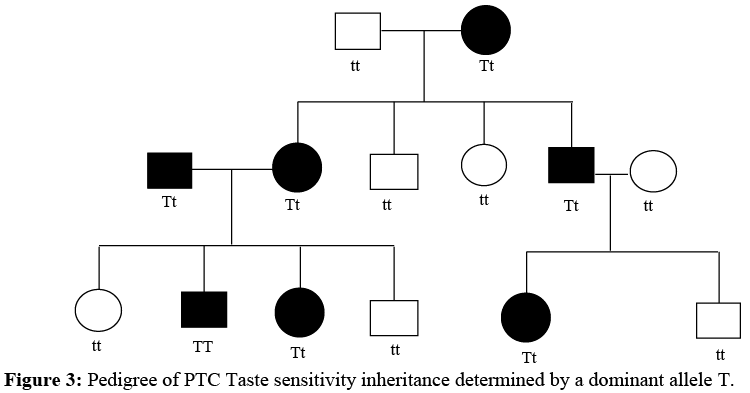 (c) X linked Recessive Inheritance
(c) X linked Recessive Inheritance
- In X-linked recessive inheritance, the affected phenotypes exhibit sex differentiation, which means that more males are affected than females. This happens because a female can only show the phenotype if both her mother and father carry the allele, while a male can show the phenotype if just his mother carries the allele.
- For instance, if the father is unaffected and the mother is affected, all of their sons will be affected, while half of their daughters will carry the affected trait. If the father is unaffected and the mother is a carrier, they will have sons, half of whom are affected and the other half are unaffected. However, when the father is affected and the mother is unaffected, none of their offspring will be affected. In this case, all sons will be unaffected, but all daughters will be heterozygous "carriers" since they inherit one of their X chromosomes from their fathers.
- Some common examples of X-linked recessive disorders in humans include hemophilia, Duchenne muscular dystrophy (DMD), and testicular feminization syndrome. Hemophilia is a well-known X-linked recessive disorder, where a person's blood fails to clot due to the absence of a protein called factor VIII. This disorder has been documented in the pedigrees of European royal families.
- In the case of hemophilia, the affected allele is represented by Xa, and the normal condition is represented by XA. A person affected by hemophilia would have the genotype XaXa for females and XaY for males. Males only need one copy of the affected allele to express the phenotype. Females who carry one copy of the affected allele (XAXa) do not show the disease phenotype but are considered carriers of the disorder. Unaffected individuals have the genotype XAXA for females and XAY for males.
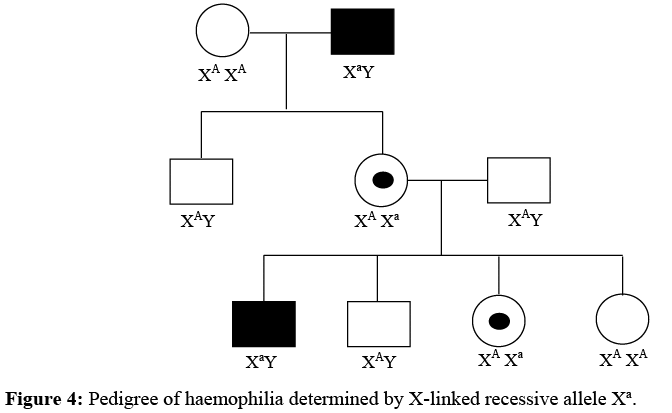 (d) X linked Dominant Inheritance
(d) X linked Dominant Inheritance
- In X-linked dominant inheritance, only one affected allele is sufficient to cause the disorder. This type of disorder is equally affected in both males and females. It is a rare inheritance disorder in humans. The affected males pass the trait on to all their daughters but to none of their sons. When the affected females married to unaffected males, the disease trait is passed on to half of their sons and daughters.
- Some of the common of examples of X-linked dominant disorders in human are hypophosphatemia, a type of vitamin D - resistant rickets, Rett syndrome, fragile X syndrome etc. For example, hypophosphatemia is determined by the presence of XD allele. Individual affected with hypophosphatemia is represented by XDXd, XDXD and XDY. Only one allele is sufficient to express the disease phenotype. Both males and females are equally affected. The normal genotype is represented by XdXd and XdY for females and males respectively (Figure 5).
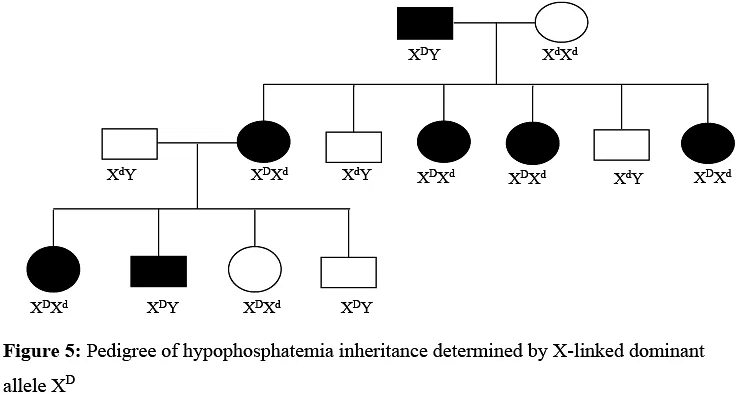
(e) Y-linked Inheritance
- Y-linked inheritance refers to the transmission of genetic traits specifically through the Y chromosome, which is present only in males. As a result, Y-linked traits are exclusively observed in males and are not present in females. Since the Y chromosome is inherited from the father, all sons of an affected father will also exhibit the trait, while none of their daughters will, as they do not receive a Y chromosome.
- In simpler terms, Y-linked inheritance is a type of genetic inheritance that is limited to males and is passed down from fathers to their sons. Daughters are not affected by these traits as they do not possess a Y chromosome.
- An example of a Y-linked disorder is Y-chromosome infertility. This condition is determined by the presence of the 'I' allele, which results in the genetic makeup 'XYI'. Males affected by this disorder will pass it on to all their sons, but none of their daughters will inherit the trait.
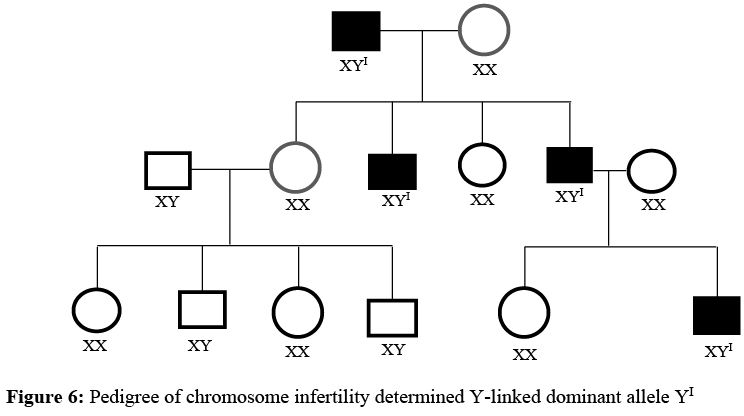 Analyzing family pedigrees is crucial for tracing the origins of disease phenotypes that may be present in family members. This analysis can also help predict the likelihood of certain events occurring in the future. Family pedigree analysis is particularly useful in genetic testing for newborns, as it can help identify the inheritance of genetic diseases. Additionally, it can be used to test for carriers of genetic conditions (heterozygotes) and screen for potential symptoms before they manifest. Genetic counselors often use individual family pedigrees to provide valuable information to families who may be at risk for various genetic conditions. By understanding a family's genetic history, they can better advise and support families in making informed decisions about their health and well-being.
Analyzing family pedigrees is crucial for tracing the origins of disease phenotypes that may be present in family members. This analysis can also help predict the likelihood of certain events occurring in the future. Family pedigree analysis is particularly useful in genetic testing for newborns, as it can help identify the inheritance of genetic diseases. Additionally, it can be used to test for carriers of genetic conditions (heterozygotes) and screen for potential symptoms before they manifest. Genetic counselors often use individual family pedigrees to provide valuable information to families who may be at risk for various genetic conditions. By understanding a family's genetic history, they can better advise and support families in making informed decisions about their health and well-being.
Conclusion
Pedigree analysis is a vital tool in understanding the inheritance patterns of genetic traits and diseases within families. By examining the relationships and transmission of specific traits across generations, researchers and medical professionals can gain insights into the underlying mechanisms of genetic inheritance. Different inheritance patterns, such as autosomal recessive, autosomal dominant, X-linked recessive, X-linked dominant, and Y-linked inheritance, can be identified through pedigree analysis. This knowledge is crucial in genetic counseling, newborn screening, and carrier testing, ultimately helping families make informed decisions about their health and well-being. By studying pedigrees, we can better comprehend the complex nature of genetic inheritance and its implications on human health.
Frequently Asked Questions (FAQs) for Pedigree Analysis
What is a pedigree chart and why is it important?
A pedigree chart is a visual representation illustrating the inheritance patterns of specific traits or characteristics across multiple generations within a family. It is important because it helps researchers and medical professionals understand the inheritance patterns of genetic diseases and traits within a particular family. This knowledge can then be used to inform genetic counseling, medical treatment, and other healthcare decisions.
What are the different types of inheritance patterns analyzed in a pedigree chart?
There are several types of inheritance patterns analyzed in a pedigree chart, including autosomal recessive, autosomal dominant, X-linked recessive, X-linked dominant, and Y-linked inheritance.
How is pedigree analysis helpful in genetic counseling and medical treatment?
Pedigree analysis helps genetic counselors and medical professionals trace the origins of disease phenotypes in family members and predict the likelihood of certain events occurring in the future. By understanding a family's genetic history, they can better advise and support families in making informed decisions about their health and well-being, including identifying carriers of genetic conditions and screening for potential symptoms before they manifest.
What are some examples of disorders that can be analyzed using pedigree charts?
Some examples of disorders that can be analyzed using pedigree charts include albinism (autosomal recessive), Huntington's disease (autosomal dominant), hemophilia (X-linked recessive), hypophosphatemia (X-linked dominant), and Y-chromosome infertility (Y-linked).
|
108 videos|243 docs
|






















